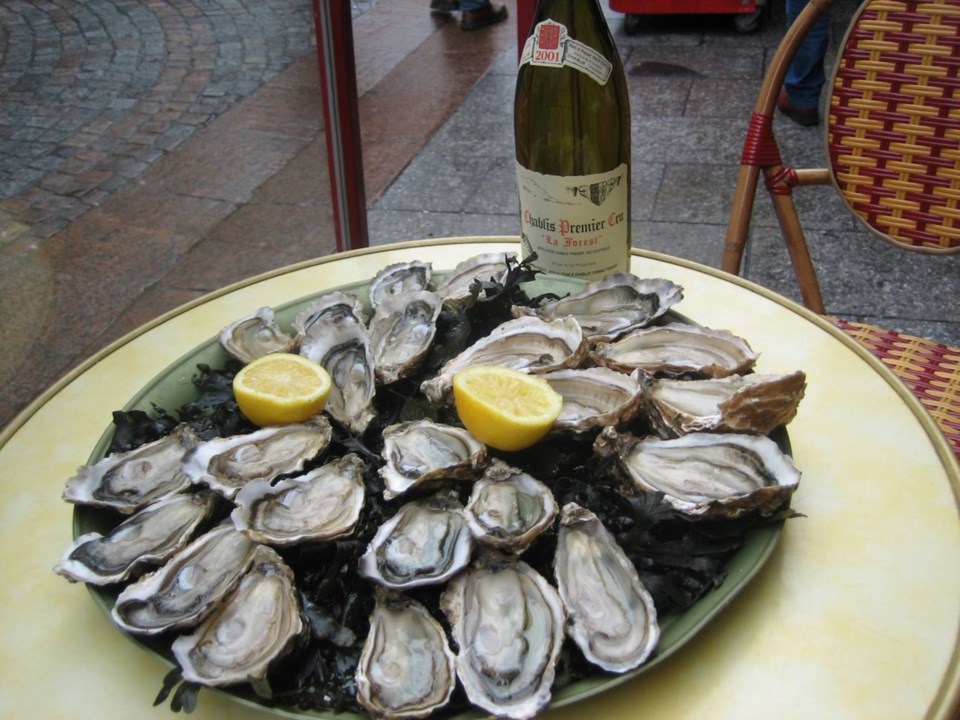The traditionalist in me avoids oysters in the summer. Perhaps I’m influenced by the old adage which warns against eating them in months that don’t have the letter ‘r’ in their name. I could also be distracted by all the other fresh seafood like spot prawns, salmon and halibut that grace the season.
Whatever my reasons, as April draws to close, I always feel compelled to indulge in a final oyster gorge.
I adorn my bivalves simply. Just a squeeze of lemon will do, though occasionally I add a sprinkling of horseradish. Really, the only essential accoutrement is a glass of crisp, clean and minerally white.
Chablis is my go-to. This cool-climate region in France produces a mouthwateringly lean and steely style of Chardonnay and the wines are typically unfettered by oak. Chablis also boasts fossilized oyster shells in its soil and sometimes you even get a whiff of this in the wines. I kid you not. Talk about echoing flavours.
Equally classic, Champagne is a truly decadent match. If you are going this splurge route, you might as well invest in an elegant Blanc de Blancs. This type of Champagne refers to the fact that it’s made from pale-skinned grapes, meaning exclusively Chardonnay.
Sauvignon Blanc is another great foil, especially when it’s flinty and restrained. The wines from the regions of Sancerre and Pouilly Fumé are the epitome of this. Fruity and more pungent examples of Sauvignon from New Zealand or Chile work well when you’re dressing up oysters with more assertive condiments, from a conventional mignonette (finely diced shallots in red wine vinegar) to more exotic Asian-influenced sauces.
Beyond the classics, explore Austria’s Gruner-Veltliner grape as well as the wines of Gavi from Italy, Picpoul de Pinet from France, and dry Vinho Verde from Portugal. I also highly recommend dry Riesling with oysters. Plenty of options abound from British Columbia, Australia and Germany, as well. (Look for the word ‘trocken’ on labels of the latter.) All the following wines, however, are guaranteed to refresh you during the warmer months ahead, whether you decide to eat oysters or not.
2014 Matua, Sauvignon Blanc, Hawkes Bay, New Zealand • $12.79* • BC Liquor Stores
Super vibrant lime and juicy nectarine with a ripe herbal zing. The best news is that it’s $2 off the regular price until the end of the month.
2013 Ormarine, Picpoul de Pinet AOC, France • $12.89* • BC Liquor Stores
Picpoul is a lesser-known grape from the South of France. Apparently its name means ‘lip-stinger’ which is an allusion to its lip-smacking acidity. Zippy indeed but ever so charming, even the oysters will be happy as they slide down your throat.
2013 Domaine de la Pepière, Muscadet Sèvre et Maine AOC Sur Lie, France • $27-30 • Private Wine Stores
Muscadet is another tried-and-true oyster pairing, and Pepière’s is particularly clean, minerally and fresh. Tons of citrus notes along with a saline tang work seamlessly with any simply prepared sea creature.
2012 Domaine Sylvain Mosnier, Chablis AOC Vieilles Vignes, France • $29.59* • BC Liquor Stores
Besides green apple and wet stone, you really do get a hint of oyster shells here. This unoaked Chardonnay vibrates with spine-tingling acidity and a persistent finish.
2010 Ferghettina, ‘Milledì’ Franciacorta Brut DOCG, Italy • $46.09* • BC Liquor Stores
Franciacorta is Italy’s answer to Champagne. It’s similarly priced but Ferghettina’s is definitely worth every penny. Its Milledì cuvée is a Blanc de Blancs, so 100 per cent Chardonnay. Elegant, creamy and complex, it offers Meyer lemon, delicate apple blossom and subtle notes of freshly baked bread.
*Prices are exclusive of taxes.



